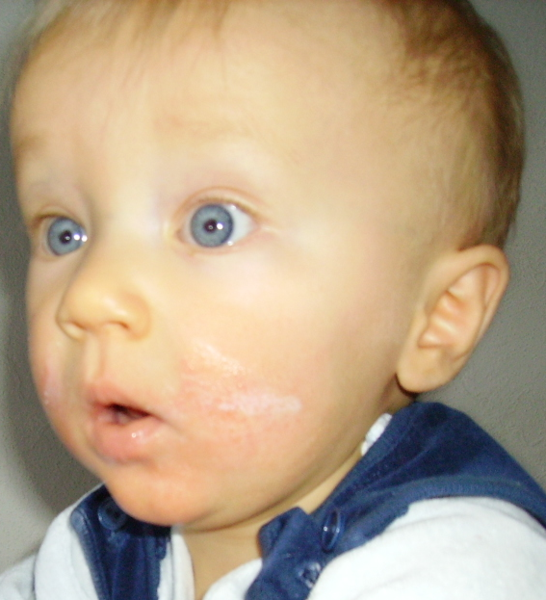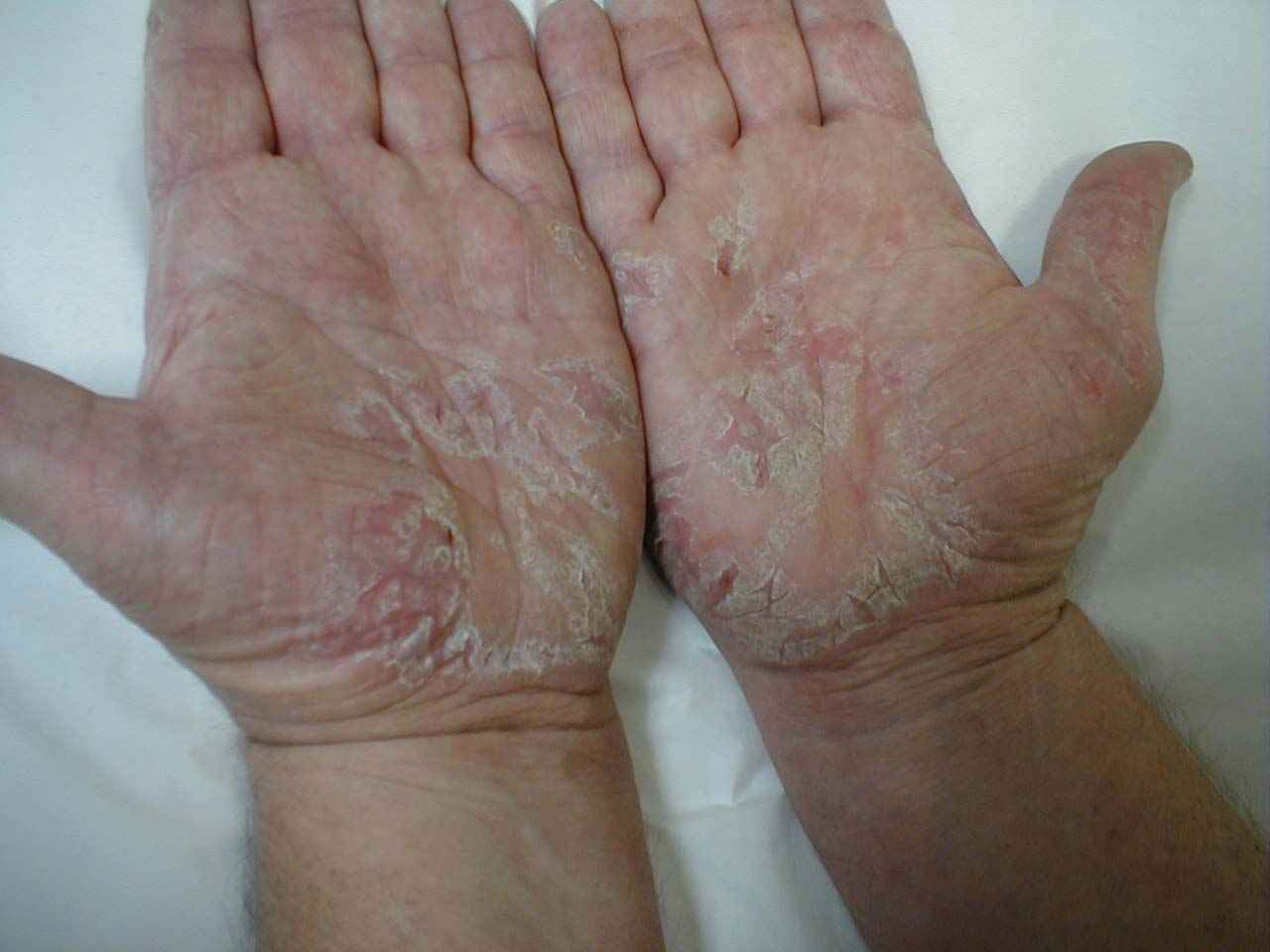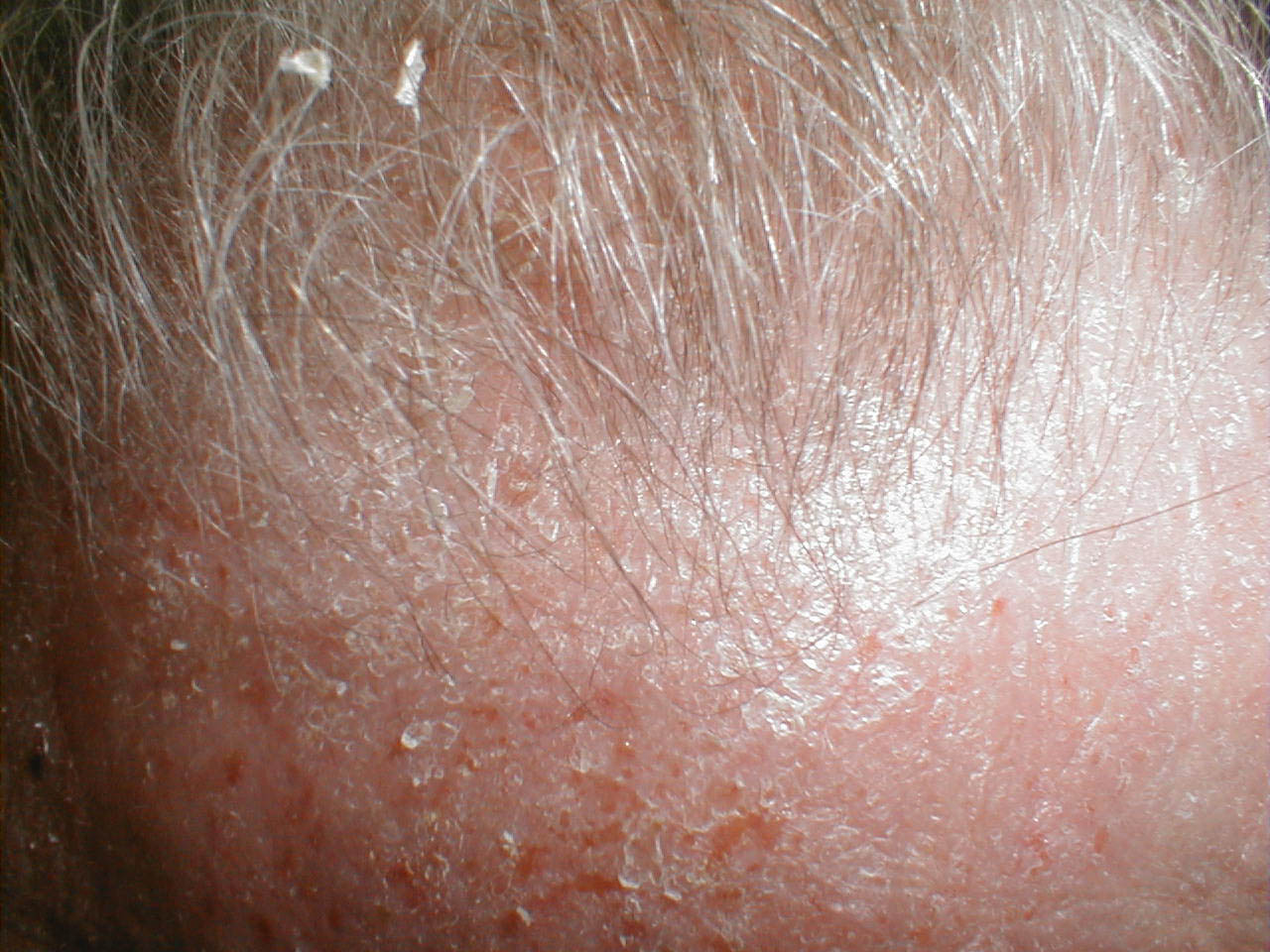Atopic dermatitis: Difference between revisions
m (Bot: Automated text replacement (-{{SIB}} + & -{{EH}} + & -{{EJ}} + & -{{Editor Help}} + & -{{Editor Join}} +)) |
No edit summary |
||
| Line 9: | Line 9: | ||
OMIM = 603165 | | OMIM = 603165 | | ||
MedlinePlus = | | MedlinePlus = | | ||
eMedicineSubj = | eMedicineSubj = | | ||
eMedicineTopic = | eMedicineTopic = | | ||
eMedicine_mult = | eMedicine_mult = | | ||
MeshID = D003876 | | MeshID = D003876 | | ||
}} | }} | ||
| Line 18: | Line 18: | ||
__NOTOC__ | __NOTOC__ | ||
{{CMG}} | {{CMG}} | ||
==Overview== | |||
'''Atopic dermatitis''', also known as Atopic Eczema, is an [[atopy|atopic]], hereditary, and non-contagious skin disease characterized by chronic inflammation of the skin. | '''Atopic dermatitis''', also known as Atopic Eczema, is an [[atopy|atopic]], hereditary, and non-contagious skin disease characterized by chronic inflammation of the skin. | ||
Revision as of 04:53, 23 August 2012
| Atopic dermatitis | |
 | |
|---|---|
| Atopic dermatitis | |
| ICD-10 | L20 |
| ICD-9 | 691.8 |
| OMIM | 603165 |
| DiseasesDB | 4113 |
| MeSH | D003876 |

|
WikiDoc Resources for Atopic dermatitis |
|
Articles |
|---|
|
Most recent articles on Atopic dermatitis Most cited articles on Atopic dermatitis |
|
Media |
|
Powerpoint slides on Atopic dermatitis |
|
Evidence Based Medicine |
|
Cochrane Collaboration on Atopic dermatitis |
|
Clinical Trials |
|
Ongoing Trials on Atopic dermatitis at Clinical Trials.gov Trial results on Atopic dermatitis Clinical Trials on Atopic dermatitis at Google
|
|
Guidelines / Policies / Govt |
|
US National Guidelines Clearinghouse on Atopic dermatitis NICE Guidance on Atopic dermatitis
|
|
Books |
|
News |
|
Commentary |
|
Definitions |
|
Patient Resources / Community |
|
Patient resources on Atopic dermatitis Discussion groups on Atopic dermatitis Patient Handouts on Atopic dermatitis Directions to Hospitals Treating Atopic dermatitis Risk calculators and risk factors for Atopic dermatitis
|
|
Healthcare Provider Resources |
|
Causes & Risk Factors for Atopic dermatitis |
|
Continuing Medical Education (CME) |
|
International |
|
|
|
Business |
|
Experimental / Informatics |
Editor-In-Chief: C. Michael Gibson, M.S., M.D. [1]
Overview
Atopic dermatitis, also known as Atopic Eczema, is an atopic, hereditary, and non-contagious skin disease characterized by chronic inflammation of the skin.
Presentation
The skin of a patient with atopic dermatitis reacts abnormally and easily to irritants, food, and environmental allergens and becomes red, flaky and very itchy. It also becomes vulnerable to surface infections caused by bacteria. The skin on the flexural surfaces of the joints (for example inner sides of elbows and knees) are most commonly affected regions in people.
Atopic dermatitis often occurs together with other atopic diseases like hay fever, asthma and conjunctivitis. It is a familial and chronic disease and its symptoms can increase or disappear over time. Atopic dermatitis in older children and adults is often confused with psoriasis. Atopic dermatitis afflicts humans, particularly young children; it is also a well-characterized disease in domestic dogs.
Although there is no cure for atopic eczema, and its causes not well understood, it can be treated very effectively in the short term through a combination of prevention (learning what triggers the allergic reactions) and drug therapy.
Prevalence
Since the twentieth century, many mucosal inflammatory disorders have become dramatically more common; atopic eczema (AE) is a classic example of such a disease. It now affects 10-20% of children and 1-3% of adults in industrialized countries, and its prevalence there has more than doubled in the past thirty years.[1]
Causes (Allergy)
Although it is an inherited disease, Eczema is primarily aggravated by contact with or intake of allergens. It can also be influenced by other "hidden" factors such as stress or fatigue. Atopic Eczema consists of chronic inflammation; it occurs in people with a history of allergy disorders such as asthma or hay fever.
Causes (Biological)
Although it is such a common disease, relatively little is understood about the underlying causes of Atopic Eczema.[2] While AE is associated with allergic asthma and allergic rhinitis, the connection between the diseases has not been established.[2] Twin studies have consistently shown that the disease has a higher rate of concordance in identical as compared to fraternal twins, which also indicates that genetics plays a role in its development.[2] However, the rate of concordance between identical twins is far from 100%, and the changing frequency of the disease over time points to the environmental factors—nutrition or hygiene, for instance—that also play a role in disease susceptibility.[3]
Genomic research into the cause of multigenic diseases is still in its infancy: few genes have ever been identified that contribute to multigenic human disorders.[3] Researchers have attempted to do this in past whole-genome screens for AE and related diseases, but their results have been inconsistent. A few of the pertinent loci have been validated by replication in further studies (chromosome 2q, chromosome 6p, and chromosome 12q, for example),[4] but most have not been.
Associations with ATOD1, ATOD2, ATOD3, ATOD4, ATOD5 and ATOD6 have been identified.[5]
Prevention
Although there is no cure for atopic eczema, treatment should mainly involve discovering the triggers of allergic reactions and learning to prevent them.
Diet: Originally controversial, the association of food allergy with atopic dermatitis has now been clearly demonstrated. Many common food allergens can trigger an allergic reaction: such as milk, nuts, cheese, tomatoes, wheat, yeast, and corn. Many of these allergens are common ingredients in grocery store products (especially corn syrup, which is a sugar substitute). Specialty health food stores often carry products that do not contain common allergens.
Environment and Lifestyle: Since dust is a very common allergen and irritant, adults with atopic eczema should likely avoid smoking, as well as the inhalation of dust in general. The dander from the fur of dogs and cats may also trigger an inflammatory response. It is a common misconception that simply removing an animal from a room will prevent an allergic reaction from occurring. A room must be completely free of animal dander in order to prevent an allergic reaction. Anger, stress, and lack of sleep are also factors that are known to aggravate eczema. Excessive heat (especially with humidity) and coldness are known to provoke outbreaks, as well as sudden and extreme temperature swings.
The Scratch Test: An allergy skin-patch or "scratch" test, given by an allergist, can often pinpoint the triggers of allergic reactions. Once the causes of the allergic reactions are discovered, the allergens should be eliminated from the diet, lifestyle, and/or environment. If the eczema is severe, it may take some time (days to weeks depending on the severity) for the body's immune system to begin to settle down after the irritants are withdrawn.
Diagnostic Findings
(Images courtesy of Charlie Goldberg, M.D.)
Treatment
The primary treatment involves prevention, which includes avoiding or minimizing contact with (or intake of) known allergens. Once that has been established, topical treatments can be used. Topical treatments focus on reducing both the dryness and inflammation of the skin.
To combat the severe dryness associated with eczema, a high-quality, dermatologist approved moisturizer should be used daily. Moisturizers should not have any ingredients that may further aggravate the condition. Moisturizers are especially effective if applied within 5-10 minutes after bathing.
Most commercial soaps wash away the oils produced by the skin that normally serve to prevent drying. Using a soap substitute such as aqueous cream helps keep the skin moisturized. A non-soap soap can be purchased usually at a local drug store. Showers should be kept short and at a lukewarm/moderate temperature.
If moisturizers on their own don't help and the eczema is severe, a doctor may prescribe topical steroid ointments or creams. Steroid creams have been traditionally been considered the most effective method of treating severe eczema. Disadvantages of using steroid creams include stretch marks and thinning of the skin. Higher-potency steroid creams must not be used on the face or other areas where the skin is naturally thin; usually a lower-potency steroid is prescribed for sensitive areas. Along with creams, antibiotics are often prescribed if an infection is suspected. If the eczema is especially severe, a doctor may prescribe prednisone or administer a shot of cortisone. If the eczema is mild, over-the-counter hydrocortisone can be purchased at the local drugstore.
The immunosuppressant Tacrolimus or pimecrolimus can be used as a topical preparation in the treatment of severe atopic dermatitis instead of traditional steroid creams. However, there can be unpleasant side effects in some patients such as intense stinging or burning.
Alternative medicines may (illegally) contain very strong steroids [6].
A more novel form of treatment involves exposure to broad or narrow-band ultraviolet light. UV radiation exposure has been found to have a localized immunomodulatory effect on affected tissues, and may be used to decrease the severity and frequency of flares [7]. In particular, Meduri et al. have suggested that the usage of UVA1 is more effective in treating acute flares, whereas narrow-band UVB is more effective in long-term management scenarios [8]. However, UV radiation has also been implicated in various types of skin cancer [9], and thus UV treatment is not without risk.
If ultraviolet light therapy is employed, initial exposure should be no longer than 5-10 minutes, depending on skin type. UV therapy should only be moderate, and care special should be taken to avoid sunburn (sunburn will only aggravate the eczema). It does not necessarily have to be administered in a hospital, it can be done at a tanning salon or in natural sunlight, so as long as it's done under the direction and supervision of a dermatologist.
Many of the same types of treatment are used in domestic dogs with atopic dermatitis. In addition, domestic dogs may be successfully managed with allergen-specific immunotherapy; many are treated with low-dose cyclosporine lipid emulsion.
Pseudoceramides
On August 27, 2007, scientists led by Jeung-Hoon Lee created in the laboratory synthetic lipids called Pseudoceramides which are involved in skin cell growth and could be used in treating skin diseases such as atopic dermatitis, a form of eczema characterized by red, flaky and very itchy skin; psoriasis, a disease that causes red scaly patches on the skin; and glucocorticoid-induced epidermal atrophy, in which the skin shrinks due to skin cell loss.[10]
Future research
It was less than ten years ago that the researchers discovered the first mouse model to spontaneously developed AE-like lesions, the inbred NC/Nga mouse.[11] These models have been used for tests that would have been impossible in humans, like the administration of Mycobacterium vaccae for the possible prevention of AE-like lesions.[12]
See also
References
- ↑ Saito, Hirohisa. Much Atopy about the Skin: Genome-Wide Molecular Analysis of Atopic Eczema. International Archives of Allergy and Immunology 2005;137:319-325.
- ↑ 2.0 2.1 2.2 Klüken, H., Wienker, T., & Bieber, T. Atopic eczema/dermatitis syndrome – a genetically complex disease. New advances in discovering the genetic contribution. Allergy 58 (2003): pp 5-12.
- ↑ 3.0 3.1 Schreiber, S. et al. Genetics of Crohn Disease, an archetypal inflammatory barrier disease. Nature Reviews Genetics 6 (2005), pp. 376-388.
- ↑ Lyle J. Palmer and William O.C.M. Cookson. Genomic Approaches to Understanding Asthma. Genome Research Vol. 10, Issue 9, 1280-1287, September 2000.
- ↑ "OMIM - DERMATITIS, ATOPIC". Retrieved 2008-09-19.
- ↑ Ramsay H M, Goddard W, Gill S, Moss C. Herbal creams used for atopic eczema in Birmingham, UK illegally contain potent corticosteroids. Archives of Disease in Childhood 2003; 88:1056-1057
- ↑ Beattie PE, Finlan LE, Kernohan NM, Thomson G, Hupp TR, Ibbotson SH. The effect of ultraviolet (UV)A1, UVB and solar-simulated radiation on p53 activation and p21. The British Journal of Dermatology. 2005 May;152(5):1001-8
- ↑ Meduri NB, Vandergriff T, Rasmussen H, Jacobe H. Phototherapy in the management of atopic dermatitis: a systematic review. Photodermatology, Photoimmunology and Photomedicine. 2007 Aug;23(4):106-12
- ↑ Jans J, Garinis GA, Schul W, van Oudenaren A, Moorhouse M, Smid M, Sert YG, van der Velde A, Rijksen Y, de Gruijl FR, van der Spek PJ, Yasui A, Hoeijmakers JH, Leenen PJ, van der Horst GT. Differential role of basal keratinocytes in UV-induced immunosuppression and skin cancer. Molecular and Cellular Biology. 2006 Nov; 26(22) pp. 8515-26
- ↑ Science Daily, New Skin-healing Chemicals
- ↑ Gutermuth, J. et al. Mouse models of atopic eczema critically evaluated. Intl Arch Allergy Immunol 135 (2004), pp. 262-276.
- ↑ Arkwright, P.D. et al. Mycobacterium vaccae reduces scratching behavior but not the rash in NC mice with eczema: a randomized, blinded, placebo-controlled trial. J Invest Dermatol 124 (2005), pp. 140-143.
External links
- NEA All About Atopic Dermatitis
- Atopic dermatitis picture page at Dermnet
- NIH Handout on Health: Atopic Dermatitis
- Template:DermAtlas
Template:Hypersensitivity and autoimmune diseases
de:Atopisches Ekzem
he:אטופיק דרמטיטיס
mk:Атопичен дерматит
nl:Constitutioneel eczeem
no:Atopisk eksem
qu:Isqhayllu
fi:Atooppinen ihottuma

